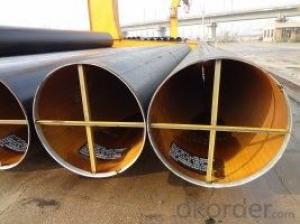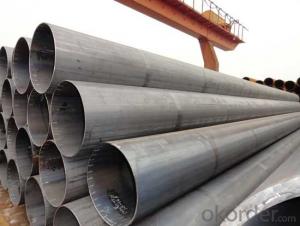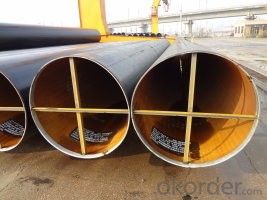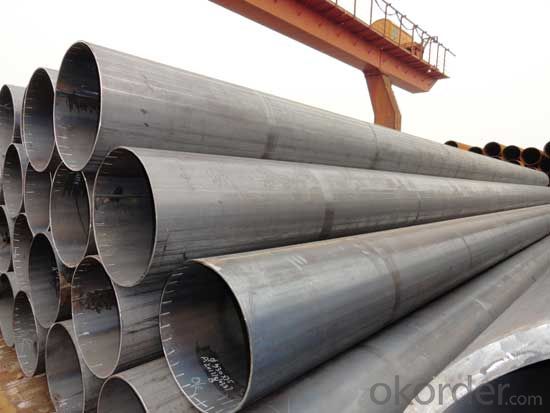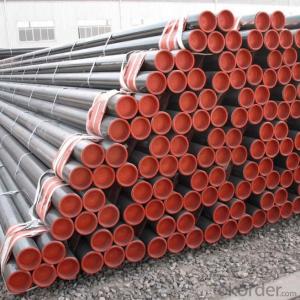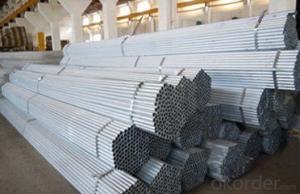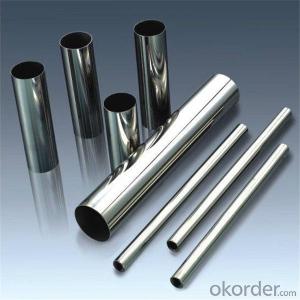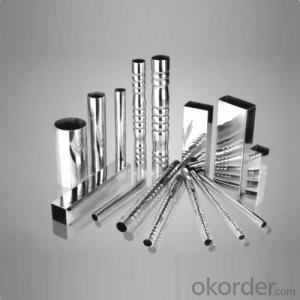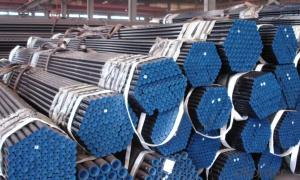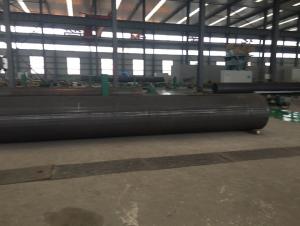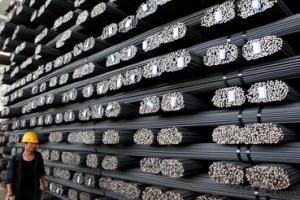large diameter JOCE LSAW Steel Pipe with Low Carbon
- Loading Port:
- Tianjin
- Payment Terms:
- TT OR LC
- Min Order Qty:
- 5 m.t.
- Supply Capability:
- 2000 m.t./month
OKorder Service Pledge
OKorder Financial Service
You Might Also Like
Product Name | ERW Pipe / Welded Pipe / Black Pipe/LSAW | |
Size | OD | 406-1522.4mm(16-56in) |
Thinkness | 8-50mm(apply to simple carbon steel,low carbon alloy steel);6.4-26.4mm(apply to X70 and above) | |
Length | 3-12.5m or as required | |
Steel Material | Gr.B,X42-X70 PSL1, X42-X80 PSL2, L245-L555NB,A516Gr, 55-70 CL11-32 | |
Standard | APISpec5L, APISpec2B, ISO383, GB/T9711-2001,ASTMA671,ASTMA672,JIS DIN, | |
Usage | Natural gas, petroleum, chemical industry, electric power, metallurgy thermodynamic fields, water supply engineering, steam heating, hydroelectric power station and long pipeline transportation projects and so on. | |
Ends | Usually Plain ,But Can Be Beveled Or By Your Choice | |
Technique | LSAW | |
Surface | Bared Or Black Painted, Galvanized Or With Oiled Or as Client Required | |
Type | Welded | |
Section Shape | Round | |
Third Party Inspection | SGS,BV,CE | |
Inspection | 100% ultrasonic flaw detection for the material plate;100% automatic on-line UT test after welding; 100% whole-length seam X-ray test; 100% inside weld line industrial TV test; 100% hydrostatic test; 100% automatic on-line seam UT test after hydrostatic test, expanding; 100% X-ray test and make X-ray film or picture record on pipe ends; 100% pipe appearance and plate appearance inspection. | |
Package | In square bundles with standard seaworthy export packing or as request | |
Date of Delivery | 5-45days according to the QTY | |
Supply Ability | 150000tons/year | |
Port of Shipment | Tianjin Port | |
Payment term | T/T, Irrevocable L/C at sight | |
Trade Term | FOB CFR CIF | |
Others | 1) Contract Manufacturing: OEM Service Offered, Design Service Offered, Buyer Label Offered 2) Small quantity can be acceptable 3) Non-standard products can be ordered 4) A strong production capacity and a large inventory guarantee the quick delivery | |
- Q: How are steel pipes used in desalination plants?
- Steel pipes are used in desalination plants to transport water, brine, and chemicals throughout the facility. They are highly durable and corrosion-resistant, making them ideal for handling the high-pressure and corrosive nature of the desalination process. Steel pipes ensure efficient and reliable water distribution, contributing to the overall effectiveness of desalination plants in converting seawater into fresh water.
- Q: What are the advantages of using steel pipes over other materials?
- Using steel pipes instead of other materials has several advantages: 1. Exceptional strength and durability: Steel pipes have the ability to withstand high pressure, heavy loads, and extreme weather conditions. This makes them suitable for various uses, such as transporting fluids and gases, providing structural support, and laying underground pipelines. 2. Enhanced resistance to corrosion: Steel pipes can be coated with different materials to increase their resistance to corrosion. This makes them ideal for transporting corrosive substances like water and chemicals without the risk of pipe degradation. Additionally, steel pipes are less prone to rust, which prolongs their lifespan. 3. Long-term cost-effectiveness: Although the initial cost of steel pipes may be higher than other materials, they offer long-term cost-effectiveness. Due to their durability and resistance to corrosion, steel pipes require less maintenance and replacement, resulting in reduced operational costs over time. 4. Versatility: Steel pipes come in various sizes, shapes, and thicknesses, making them versatile for different applications. They can be easily customized and fabricated to meet specific requirements, such as bending, welding, and threading. 5. Fire resistance: Steel pipes have a high melting point, making them resistant to fire and reducing the risk of structural damage in case of a fire incident. This characteristic is particularly important in industries where fire safety is crucial, such as oil and gas, chemical, and construction. 6. Environmentally friendly: Steel is a recyclable material, and steel pipes can be recycled and reused multiple times without compromising their quality. This not only reduces the demand for new materials but also contributes to environmental sustainability. 7. Excellent flow characteristics: Steel pipes have smooth internal surfaces, minimizing friction and allowing for efficient flow of fluids and gases. This advantage is particularly significant in industries where fluid dynamics and energy efficiency are essential, such as oil and gas, water supply, and HVAC systems. In conclusion, steel pipes offer numerous advantages over other materials, including strength, durability, corrosion resistance, cost-effectiveness, versatility, fire resistance, eco-friendliness, and excellent flow characteristics. These advantages make steel pipes the preferred choice for a wide range of applications in various industries.
- Q: What is the thermal conductivity of steel pipes?
- The specific type of steel used and its composition can cause variations in the thermal conductivity of steel pipes. On average, the thermal conductivity of steel pipes ranges between 50-60 watts per meter-kelvin (W/mK). This indicates that steel pipes possess a relatively high ability to conduct heat, facilitating efficient thermal energy transfer. Given their high thermal conductivity, steel pipes find suitability in numerous applications such as heating systems, industrial processes, and infrastructure projects where heat transfer plays a crucial role.
- Q: How are steel pipes cleaned and maintained?
- Steel pipes are cleaned and maintained through various methods. The process typically involves removing any debris or rust from the pipes using wire brushes or sandblasting. After cleaning, a protective coating is applied to prevent corrosion. Regular inspections and maintenance checks are also conducted to identify any potential issues such as leaks or weak points, ensuring the pipes remain in optimal condition.
- Q: Can steel pipes be used for transporting slurry?
- Yes, steel pipes can be used for transporting slurry. Steel pipes are commonly used in various industries, including mining, construction, and oil and gas, for transporting different types of fluids, including slurry. Slurry is a mixture of solid particles suspended in a liquid, usually water, and steel pipes have the required strength and durability to handle the abrasive nature of slurry. Additionally, steel pipes have excellent resistance to corrosion, which is crucial when dealing with slurry that may contain corrosive elements. The smooth inner surface of steel pipes also helps to minimize friction and ensure efficient flow of the slurry. Overall, steel pipes are a reliable and commonly used choice for transporting slurry due to their strength, durability, corrosion resistance, and smooth inner surface.
- Q: Can steel pipes be used for oil well casing?
- Yes, steel pipes can be used for oil well casing. Steel is a commonly used material for oil well casing due to its strength, durability, and resistance to corrosion.
- Q: What is the process of coating steel pipes?
- The process of coating steel pipes involves applying a protective layer on the surface of the pipe to prevent corrosion and increase its durability. This typically includes cleaning the pipe to remove any contaminants, followed by applying a primer to improve adhesion. The pipe is then coated with a layer of paint or a specialized coating material using a variety of techniques such as spraying, dipping, or electrostatic application. The coated pipe is then cured or dried to ensure the coating adheres properly. This process helps to ensure the longevity and performance of steel pipes in various applications.
- Q: Can steel pipes be painted?
- Yes, steel pipes can be painted. Painting steel pipes provides protection against corrosion, enhances their aesthetic appearance, and can help them blend with the surrounding environment. Prior to painting, the pipes need to be cleaned, primed, and then coated with a suitable paint designed for metal surfaces.
- Q: What are the different testing methods used for steel pipes?
- There are several testing methods used for steel pipes to ensure their quality and reliability. Some of the commonly used testing methods include: 1. Non-destructive Testing (NDT): NDT methods such as ultrasonic testing, magnetic particle inspection, and liquid penetrant testing are used to detect any surface or subsurface defects in the steel pipes without causing any damage to them. 2. Mechanical Testing: Mechanical testing involves conducting various tests to evaluate the mechanical properties of steel pipes, including tensile strength, yield strength, elongation, hardness, and impact resistance. These tests help determine the structural integrity and performance of the pipes. 3. Hydrostatic Testing: This method involves subjecting the steel pipes to high-pressure water to check their ability to withstand the expected operating conditions. Hydrostatic testing is performed by filling the pipes with water and pressurizing them to a predetermined level for a specified duration. Any leakage or deformation in the pipes is detected during this test. 4. Dimensional Inspection: This testing method ensures that the steel pipes meet the specified dimensional requirements. It involves measuring the diameter, wall thickness, length, and other critical dimensions of the pipes to verify compliance with the applicable standards or specifications. 5. Visual Inspection: Visual inspection is a basic method used to assess the external appearance of steel pipes. Trained inspectors visually examine the pipes for any surface defects, such as cracks, corrosion, or irregularities in shape or finish. 6. Chemical Analysis: Chemical analysis is performed to determine the composition and elemental content of the steel pipes. It helps ensure that the pipes are made from the correct grade of steel and meet the required chemical composition standards. 7. Metallographic Examination: Metallography involves examining the microstructure of steel pipes under a microscope to assess their quality and integrity. It helps identify any internal defects, such as grain boundaries, inclusions, or improper heat treatment, that may affect the overall performance of the pipes. By utilizing these testing methods, manufacturers and inspectors can ensure that steel pipes meet the necessary quality standards and are suitable for their intended applications.
- Q: Can steel pipes be used for structural purposes?
- Yes, steel pipes can be used for structural purposes. They are often used in construction projects to create strong and durable building frameworks, as well as in various engineering applications where load-bearing capacity is required.
Send your message to us
large diameter JOCE LSAW Steel Pipe with Low Carbon
- Loading Port:
- Tianjin
- Payment Terms:
- TT OR LC
- Min Order Qty:
- 5 m.t.
- Supply Capability:
- 2000 m.t./month
OKorder Service Pledge
OKorder Financial Service
Similar products
Hot products
Hot Searches
Related keywords
